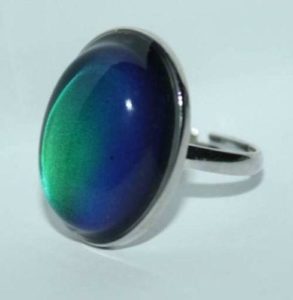
Technology was a fast-moving thing for us Boomers.
True, the quantum leaps in miniaturized electronics that take place every other day today are far greater than innovations were for us, but still, many completely new concepts were hatched during our heyday.
For example, during the late 1960’s, thermotropic thermometers became popular as hassle-free instruments to take nervous kids’ temperatures.
All you did was lay the little plastic strip on the sick child’s forehead, and the temperature would be magically displayed by a number that would show up against a dark background.
The technology used liquid crystals, which would align their molecules at various temperature ranges, thereby changing their colors.
A jewelry designer named Marvin Wernick observed a doctor using one of the magic thermometers in the late 60’s and envisioned a gold mine.
Wernick obtained some of the thermotropic material and placed a thin layer of it under a rounded glass face. Once the assembly was mounted on a ring base, the mood ring was born.
Wernick also penned a little blurb that was included with the ring, and the foundation was laid for a brand new craze.
The ring’s colors were to be interpreted thusly:
* Dark blue: Happy, romantic or passionate
* Blue: Calm or relaxed
* Blue-green: Somewhat relaxed
* Green: Normal or average
* Amber: A little nervous or anxious
* Gray: Very nervous or anxious
* Black: Stressed, tense or feeling harried
The whole thing was based on the temperature changes of human skin. Many of us fervently believed in the power of mood rings to display our emotional state to the world. Many of us figured out that the odds of taking an accurate temperature on a digit exposed to the environment were slim, and besides, our skin temperature really didn’t have a whole lot to do with our state of mind.
Oh well, they were fun, they were cool, and they were cheap.
As the 70’s progressed, mood rings spread all over the nation, and much of the rest of the world.
Then, as all fads do, one day they began to be seen as passe. Sales slumped, they vanished.
Then, as many of those passe fads do, they began to be seen as retro and cool. They reappeared. Sales picked back up, although nowhere near the numbers during the 70’s.
Nowadays, a Google search for mood rings turns up all sorts of them offered for sale online cheap. For that matter, a trip to your local convenience store will likely reveal a display box full of them next to the cheap sunglasses and the faux-stimulants.
Boomer reader, why not grab yourself a mood ring for a couple of bucks? There aren’t too many fad items from our younger years so easily available. And you will be seen by the young kids currently running this world as being strangely retro-cool.